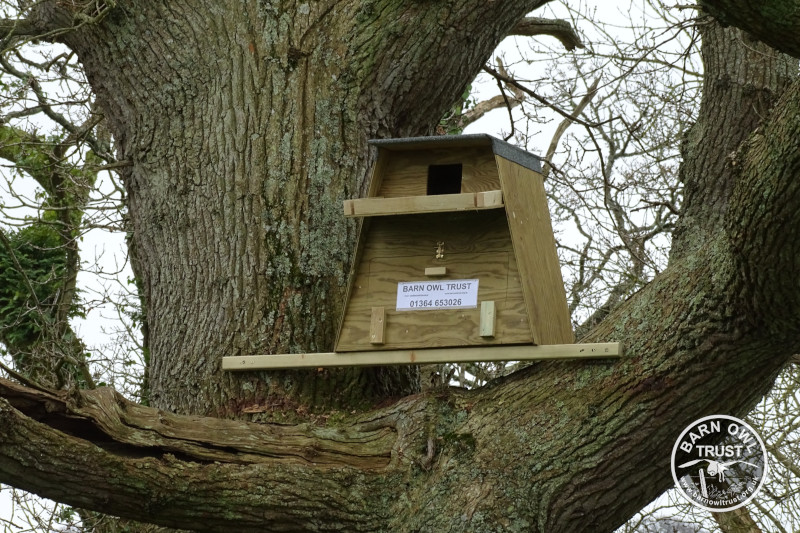Barn Owl nestboxes for trees
Firstly, have you considered putting a Barn Owl box inside a building?
There are lots of reasons why Barn Owl boxes in buildings are better than nestboxes in trees. They are cheaper too!
However, if you have a suitable tree, tree boxes are much more practical than boxes on poles.
Do you have a suitable tree?
An ideal tree would be:
- A mature tree with a thick trunk
- Isolated, in a hedgerow or on the woodland edge
- With a high canopy
- With few or no low branches
- Where a nestbox can be placed at least 3 metres above ground level
- Where the nestbox access hole would be visible to a passing owl, even when the tree is in full leaf and seen from a distance
- Quite close to strips or patches of rough grassland
- If the box hanging system involves screwing or nailing into a tree, then please choose a dead tree, where possible
Watch the video above or see our Photoguide: Choosing the right tree for a Barn Owl box.
This ideal tree stands in a patch of good habitat.
Why we don’t recommend fixing a tree box on a pole or outside wall of a building:
- On a live tree, owls benefit from additional shelter. On a pole they are far more exposed.
- A tree box with an internal depth of 450mm reduces the chance of owlets falling (before they are ready to fly) but it does not eliminate the danger entirely. With a well designed tree-mounted box, a fallen owlet might be able to scramble up the tree trunk and re-enter the box. In the case of a tree box mounted on a pole, this is impossible.
- A well designed pole box is much bigger and much deeper than one designed for fixing to a tree. This eliminates the danger of owlets falling because they cannot get out until they are able to fly.
- Rather than erect a tree box on an outside wall, it’s much better to create an entrance hole and erect a modified interior nestbox on the inside (up against that hole) if owls cannot be given access to the building interior.
Top tips for nestbox trees:
- Barn Owls are interested in holes rather than boxes.
- Face the access hole towards open ground but avoid the prevailing weather if possible.
- Trees with low branches/leaves and trees screened by other trees/buildings are not suitable because the access hole will be hidden.
- Tree boxes within woodland are very unlikely to attract Barn Owls.
A mixed farming landscape with patches and strips of rough grassland is ideal.
Is your landscape suitable?
- Barn Owl nest boxes in the UK & Ireland should be placed in open countryside in isolated trees or trees that overlook open habitat.
- Avoid urban, suburban, dense forest and high mountain areas.
- Sites within 1 km of a motorway or other fast, unscreened main road should be avoided due to the risk of road-deaths.
- Nestboxes do not need to be placed within rough grassland as the birds are perfectly capable of ‘commuting’ across unsuitable habitats before starting to hunt and have very large home ranges.
- Check to see if your local landscape is suitable.
You can build a Barn Owl treebox or you can simply buy a Barn Owl Trust nestbox for fixing to a tree.
Barn Owl tree nestbox instructions
- Dimensions
- Materials to use
– Preservative
– Waterproofing - Barn Owl box plan and construction
- How to put up a tree box
- Your safety
- How and when to clean it out
- Essential requirements for Barn Owl tree box designs
SAFETY NOTE: This video was recorded several years ago and we have since improved our methods around hot working. Please do carry out all felting in an open outdoor setting and with a suitable blowtorch stand.
Dimensions
The dimensions given in the owl box plans below must be treated as the minimum required size.
Ideal Barn Owl boxes would be much bigger: a full 1 metre from the bottom of the entrance hole to the bottom of the box and with a floor area of at least 1m x 1m. However, owl boxes that big would be very difficult to erect and more expensive to build.
American Barn Owls are larger: Dimensions for a Barn Owl nestbox in the USA.
Materials to use
The basic owl box should be built using rot-resistant or Tanalith E treated sheet material manufactured using a waterproof adhesive. We use 9mm exterior grade tanalised softwood ply (or structural exterior grade ply complying with EN314-2 Class 3, CE2+ or C+/C), 25 x 50mm tanalised batten and 30mm rust-resistant screws. Please avoid using hardwood ply, unless it is stamped “FSC Approved”.
Wood preservative
Where tanalised plywood is not available, any type of wood preservative may be used provided that the box is dry before erection. It is essential that the edges and ends of all parts are treated before assembly.
Waterproofing
The top of the owl box should be covered with heavy duty roofing felt. A waterproof sealant (such as Ever-Build Weather-Mate) should be used in all the wood joints to prevent water seeping in. If you need proof that this is necessary, try leaving your nestbox under a sprinkler for a few hours. 20mm diameter ventilation/drainage holes can also be drilled in the floor of the box. The front, back and sides must overhang the floor of the box.
Note:
The use of external preservative and waterproof sealant in the joints will not stop the plywood de-laminating. You must choose plywood made with a waterproof adhesive (EN314-2, Class 3).
How to build a Barn Owl tree nestbox
Watch the video above or have a look at our photo guide – how to build a Barn Owl Tree Nestbox.
- Our deep nest box design is much safer for owlets due to a 450mm drop from the entrance hole to the floor and a landing tray with a raised edge.
- If you wish to vary from this owl box diagram, please check our essential design criteria for exterior Barn Owl boxes.
How to erect Barn Owl nestboxes for trees
Watch the video below or see our photo gallery showing the 2 methods to use when erecting Barn Owl boxes for trees.
(NB: A ‘Nestbox Hanging Kit’ is included with all Barn Owl Trust tree nestboxes.)
Your safety
Before erecting a Barn Owl box, please ensure that you have properly assessed the risks involved, particularly with regard to working at height. An outdoor box is quite heavy to lift single-handed and using ladders is potentially dangerous. Please do not work alone and consider using 2 ladders with appropriate PPE (Personal Protective Equipment such as fall arrest and ladder anti-slip equipment), or safer methods. The most important thing when erecting the box is your own safety.
Human access and cleaning out
The front of the owl box should have an access panel to enable nest debris to be cleared out periodically. The internal depth of the nestbox is important as it reduces the chances of a nestling Barn Owl falling from the box and dying as a result of neglect or predation. Therefore, it is important that the box depth is maintained by clearing out the box once it has more than about 75mm of nest debris. If Jackdaws use the box, it must be cleaned out every year (wear gloves and a dust mask). Boxes used only by breeding Barn Owls will need clearing out every 2 or 3 years. Remember that under the Wildlife and Countryside Act 1981, it is an offence to disturb breeding Barn Owls so nestboxes should only be cleaned out between November and January, and preferably in dry, calm weather, so that any roosting owl doesn’t get flushed out into the rain or wind.
Minimum requirements for Barn Owl treebox designs
If you choose to use a different design for your tree nestbox, ensure it meets these design criteria:
- Entrance hole: Optimum size: 130 x 130mm; minimum size: 100 x 100mm; maximum size: 150 x 150mm.
- Floor area of nest chamber: Good size range: 0.2 to 0.4m2; absolute minimum: 0.16m2.
- Depth from bottom of entrance hole to nest must be not less than 450mm.
– NB: owl boxes with less depth may be acceptable if placed within the branches of a tree that a fallen nestling could climb, however, deep owl boxes are so much safer that we no longer recommend boxes with less depth.
– The ideal size for Barn Owl boxes is 1m2 (floor area) x 1m depth but such big boxes are generally impractical. - For any Barn Owl nestbox less than 700mm deep, an exercise/landing platform below the entrance hole is vital for the safety of young fledglings. Climbing/jumping young birds can get from the platform onto the roof of the box and (ideally) onto other nearby perching places.
– The platform must have a generous raised edge suitable for Barn Owls to grip easily and it should be positioned, and have sufficient shelter and drainage, to prevent rainwater being deflected into the box entrance. - Interior must remain dry during prolonged heavy rain coming from any direction.
- All sides should overhang the floor. Outdoor nestboxes usually have ventilation/drainage holes. However, any nestbox that actually needs drainage holes to let rainwater out is a very poor design and should not be used.
- There must be sufficient height difference between the nest and the external platform so as to prevent the accumulation of a continuous (internal/external) layer of pellet debris allowing rainwater to soak through the debris to the inside thereby chilling the nest contents.
- Roof should be covered in thick roofing felt guaranteed for not less than 10 years. Very steeply sloping roofs may not need covering but any apex join must be permanently waterproofed.
- Human access for easy clearing-out of nest debris is essential.
- Timber liable to decay within 20 years must be treated with long-lasting preservative: either pressure treated (tanalised) or surface treated including all edges of all component parts before assembly (follow product instructions and make sure all parts are dry before assembly). Plywood used must be manufactured using a waterproof adhesive (EN-314-2, Class 3).
- All screws/nails and any metal fittings used should be rust proof.
- Measures aimed at reducing the chances of entry by other species (such as Jackdaws and Beech Martens) are to be encouraged provided that they do not significantly reduce the box’s suitability for Barn Owls.
- Should be substantially constructed yet light enough to permit safe erection using basic equipment. Normal treebox weight range is 13-18kg. Total weight should not exceed 25kg and a tree box under 10kg is probably not substantial enough.
- Should not be constructed from tropical hardwood unless the timber is certified as sustainably grown (FSC approved).
- Barn Owl boxes should be supplied with information that specifies an erection height of not less than 3m above ground level and stresses the importance of positioning within the tree branches in the case of boxes that have less than 450mm internal drop.
– Information provided with owl boxes should also cover the following subjects: foraging habitat requirements, nestbox positioning to maximise the chances of occupation (entrance hole visibility), the need for clearing out debris so as to maintain internal depth, nest box erection and attachment methods, human safety issues. - As a general rule, Barn Owl boxes should not be erected within 1 km of any motorway, dual-carriageway or similar unscreened major road.
- Avoid poor nestbox design


